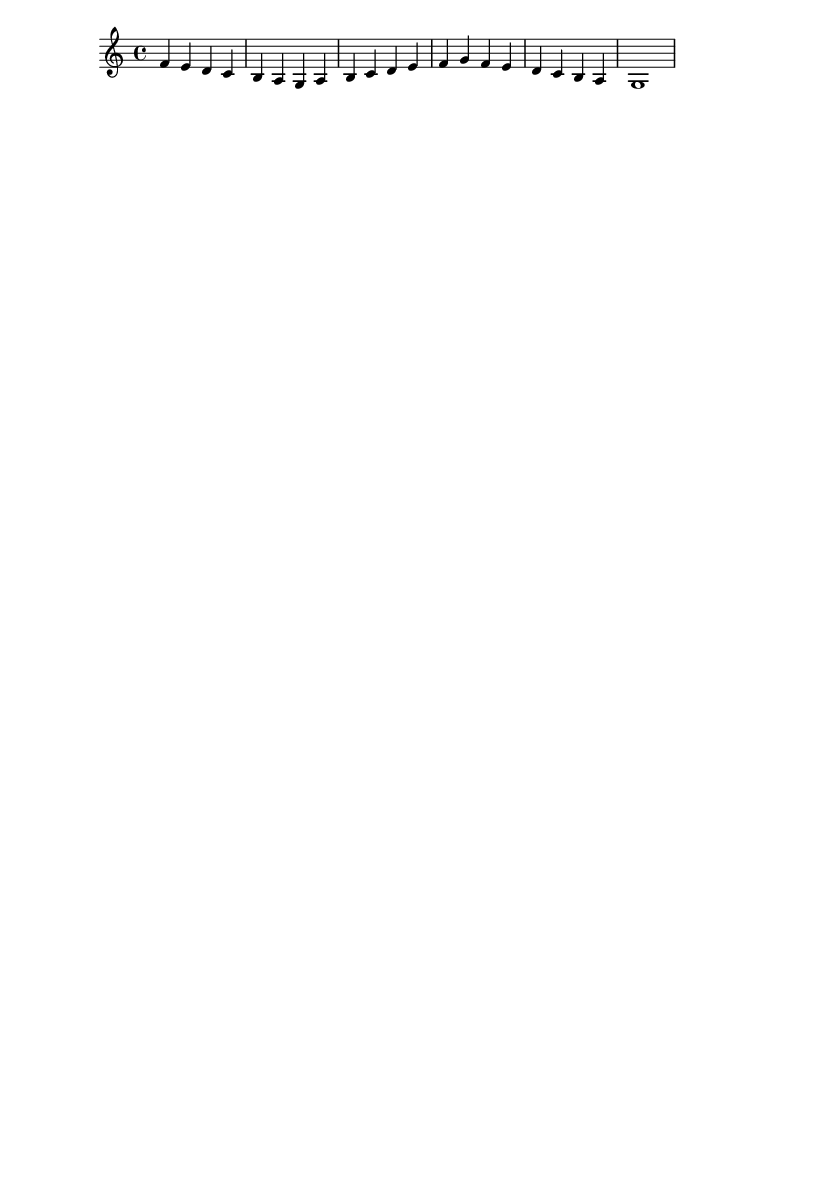Music theory
— Albert De La Fuente Vigliotti- Tests to take
- Music theory
- How to build scales and triads
- Questions
- Intervals
- Fretboard patterns
- Scales formulas
- Scales chart / Campo harmonico
- Circle of fifths / order of sharps and flats
- Circle of 5ths: Easiest Way to Memorize and Understand It - YouTube [how to memorize and build the circle of 5ths]
- 7 Ways To Actually Use the Circle of 5ths - YouTube [other uses and how to use the circle of 5ths, best video]
- GitHub - mreintz/circleOfFifths: Simple Circle of Fifths application showing chords in key, notes in chord, and suggested chord progressions for each key and mode.
- GitHub - MrNovado/circle-of-5ths: Interactive circle of fifths with chords and modes; also plays chords using howler
- Ancient Jewish/Hebrew scales
- Modes
- Poly-rhythms and Euclidean rhythms
- Coltrane
- Song structure
- Instruments
- Piano
- Bass - Scales with score and tab
- 0b - C Major - C - Dm - Em - F - G - Am - Bd
- 1b - F Major - F - G - A - Bb - C - D - E
- 2b - Bb Major - Bb - C - D - Eb - F - G - A
- 3b - Eb Major - Eb - F - G - Ab - Bb - C - D
- 4b - Ab Major - Ab - Bb - C - Db - Eb - F - G
- 5b - Gb Major - Gb - Ab - Bb - Cb - Db - Eb - F
- 6b - Db Major - Db - Eb - F - Gb - Ab - Bb - C
- 7b - Cb Major - Cb - Db - Eb - Fb - Gb - Ab - Bb
- Software
- Links
- Music theory websites:music_theory:
- Music Theory Cheat Sheet: Keys, Scales, Chords, Notes & Intervals
- Musescore: online music courses | Learn how to play, read and compose music with the world’s largest sheet music catalog
- Harmonagon™
- Songs With The Same Chords / Hooktheory trends tool for composing
- This FREE Tool Lets You Write PERFECT Chord Progressions Every Time 🎶 - YouTube:composition:markov:progression:
- Chords & Scales Reference🎸piano:chords:scales:
- #fretflip - Pentatonic and diatonic scales🎸chords:scales:
- Music theory training software
- Learning the Piano on your Linux computer with Playground Sessions! - YouTube
- GitHub - la-jarre-a-son/midi-jar: MIDI Jar is a tool box for musicians, learners, streamers, that want to route MIDI message between devices, and display a piano or chords while playing, and integrate it on a video or on a Twitch stream.
- Ear training
- Backtracks
- Music theory in the terminal or libraries
- Lessons/Training [Linux-Sound] / linuxaudio.org
- gciruelos/musthe: Music theory implemented in Python. Notes, intervals, scales and chords.
- GitHub - synestematic/kord: a music theory development framework in python:python:
- https://github.com/yuma-m/pychord
- GitHub - pedrozath/coltrane: 🎹🎸A music theory library with a command-line interface:ruby:
- GitHub - Rainbow-Dreamer/musicpy: Musicpy is a music programming language in Python designed to write music in very handy syntax through music theory and algorithms.:composition:
- kennethreitz/pytheory: Music Theory for Humans.
- allan-simon/linthesia: tentative to fix/rewrite linthesia , an open-source synthesia/ “piano-hero” like game
- ZaneH/piano-trainer: Memorize piano scales with ease! A piano practice program w/ MIDI support. Consider it an interactive reference manual 🎹
- Music analysis
- Music diagrams, cheat sheets, fretboard, piano
- Music theory visualization systems
- Music theory software to practice
- Music production software on linux
- Music app websites
- Plugins
- Devices
- Scale degrees
- Diatonic scales
- Awesome music
- Things to organize
- Music theory websites:music_theory:
Tests to take #
- US: AP music theory exam for high school students
- UK: ABRSM music theory (grade 6 or so)
Music theory #
How to build scales and triads #
C Major scale #
In Linux you can visualize and play a virtual midi keyboard using vmpk.
The major scales are based on the distance steps between semitones structure from C considering only the white keys (whole tones). For instance:
- C to D equals 2 semitones
- D to E equals 2 semitones
- E to F equals 1 semitone
- F to G equals 2 semitones
- G to A equals 2 semitones
- A to B equals 2 semitones
- B to C equals 1 semitones
So the formula is: 2, 2, 1, 2, 2, 2, 1.
Once you have the scale, each note builds a triad. Triads can be major or minor. A major triad has 4 steps until the second note and 3 more steps until the third note. For example, C would form a triad with E and G. C and add 4 semitones (C#, D, D#, E), and from there add 3 semitones (F, F#, G).
There is just one detail to remember. Major scales have this pattern: MmmMMmd
(M being major, m being minor and d being diminished). A major chord adds
4 semitones and then 3. A minor chord adds 3 and then 4. A diminished chord adds
3 and then 3 semitones.
Now let’s visualize that…
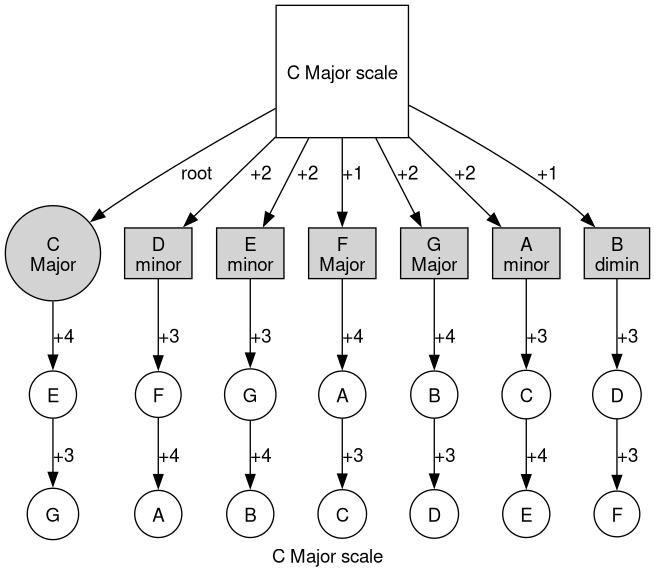
I also like to represent this on a short table like this:
| C Major | 1 | 2 | 3 | 4 | 5 | 6 | 7 |
|---|---|---|---|---|---|---|---|
| root | C | ||||||
| Major/minor | M | m | m | M | M | m | d |
| major formula | 2 | 2 | 1 | 2 | 2 | 2 | 1 |
| 1st triad note | C | D | E | F | G | A | B |
| + | 4 | 3 | 3 | 4 | 4 | 3 | 3 |
| 2nd triad note | E | F | G | A | B | C | D |
| + | 3 | 4 | 4 | 3 | 3 | 4 | 4 |
| 3rd triad note | G | A | B | C | D | E | F |
I love to code and often I use the computer to teach myself, in this case I am
going to use the musthe python lib to generate the same scale and all the
triads so I can check my answers. I will use this snippet:
from musthe import *
import pandas as pd
def build_triads_df(key_note, scale_type, modes):
result = []
scale = []
scale = Scale(key_note, scale_type)
result_lst = []
for i in range(len(scale)):
mode = modes[i]
triad = Chord(scale[i], mode)
result.append([scale[i], triad.notes[0], triad.notes[1], triad.notes[2]])
i += 1
df = pd.DataFrame(result, columns=['scale_note', 'triad_1st', 'triad_2nd', 'triad_3rd'])
return(df, result)key_note = Note('C')
scale_type = 'major'
df, lst = build_triads_df(key_note, scale_type, 'MmmMMm°')
dfNote that the pandas table is transposed compared to the one I did manually.
Again, I like using software to help me to teach myself new things. I found a Ruby gem called Coltrane that allows to print in the terminal a scale represented in piano and guitar. Here is an example:
C Minor scale #
Now I am going to generate the C Minor scale. It is generated in the same way as C Major but based as starting in A (only white keys in the piano).
The formula is: 2, 1, 2, 2, 1, 2, 2.
| C minor | 1 | 2 | 3 | 4 | 5 | 6 | 7 |
|---|---|---|---|---|---|---|---|
| root | C | ||||||
| Major/minor | m | d | M | m | m | M | M |
| minor formula | 2 | 1 | 2 | 2 | 1 | 2 | 2 |
| 1st triad note | C | D | Eb | F | G | Ab | Bb |
| + | 3 | 3 | 4 | 3 | 3 | 4 | 4 |
| 2nd triad note | Eb | F | G | Ab | Bb | C | D |
| + | 4 | 3 | 3 | 4 | 4 | 3 | 3 |
| 3rd triad note | G | Ab | Bb | C | D | Eb | F |
Now I am going to double check my work using musthe:
key_note = Note('C')
scale_type = 'natural_minor'
df, lst = build_triads_df(key_note, scale_type, 'm°MmmMM')
dfAnd finally render that scale on coltrane.
How cool is that, huh?
G minor scale #
key_note = Note('G')
scale_type = 'natural_minor'
df, lst = build_triads_df(key_note, scale_type, 'm°MmmMM')
dfQuestions #
The book Hack Music Theory, Part 1 has helped me tremendously and I would highly recommend it. It is easy to follow. Here I have answered the questions.
Scales #
Q1. The enharmonic of D# is: [OK] A: Eb
Q2. The enharmonic of Gb is: [OK] A: F#
Q3. Write one octave of the E major scale: [OK] Formula: 2212221 (based on C) A: E F# G# A B C# D# E
Q4. Write one octave of the Db major scale: [OK] Formula: 2212221 (based on C) A: Db Eb F Gb Ab Bb C Db
Q5. Write one octave of the G natural minor scale: [OK] Formula: 2122122 (based on A, or 9 semi-tones from C) A: G A Bb C D Eb F G
Q6. Write one octave of the F# natural minor scale: [OK] Formula: 2122122 (based on A, or 9 semi-tones from C) A: F# G# A B C# D E F#
Q7. What is Bb major’s relative minor scale? [FAIL] Explanation: Add 9 semi-tones (or the equivalent of 5 tones from C) A: G minor
Explanation: counted poorly
Q8. What is E natural minor’s relative major scale? [OK] Explanation: Subtract 9 semi-tones (or the equivalent of 5 tones from C) A: G major
Q9. Which scale has the following scale spelling: 1 2 3 4 5 6 7 8? [FAIL] A: Major scale
Explanation: I thought it was C, but it is the major scale.
Q10. Write the scale spelling of the natural minor scale: [FAIL] A: 1 2 b3 4 b5 b6 7
Explanation: It is the difference between the intervals of the major and minor, example:
| Formula | |||||||
|---|---|---|---|---|---|---|---|
| 1 | 2 | 3 | 4 | 5 | 6 | 7 | |
| 2212221 | C | D | E | F | G | A | B |
| 2122122 | C | D | Eb | F | G | Ab | Bb |
| 1 | 2 | b3 | 4 | 5 | b6 | 7 |
Chords #
Q1. Write the notes of the Eb major triad: [OK] A: Eb G Bb
Q2. Write the notes of the B major triad: [OK] A: B D# F#
Q3. Write the notes of the B minor triad: [OK] A: B D F#
Q4. Write the notes of the F minor triad: [FAIL] A: F Ab C
Reason: counted poorly
Q5. Name the following triad: Gb Bb Db [OK] A: Gb major
Q6. Name the following triad: E G B [OK] A: E minor
Q7. What is the interval between the root note and the note C in the Ab maj triad? [FAIL] A: 4 (major 3rd)
Q8. What is the interval between the root note and the note D in the G# dim triad? [FAIL] A: 6 (dim 5th)
Q9. Using chord symbols, write the triads that are built from each degree of the F major scale: [OK] A: F-maj G-min A-min Bb-maj C-maj D-min E-dim
| Major fm | 2 | 2 | 1 | 2 | 2 | 2 | 1 |
|---|---|---|---|---|---|---|---|
| Deg fm | M | m | m | M | M | m | d |
| F Major scale | F | G | A | Bb | C | D | E |
| Triad 2nd | A | Bb | C | D | E | F | G |
| Triad 3rd | C | D | E | F | G | A | Bb |
Q10. Using chord symbols, write the triads that are built from each degree of the E natural minor scale: [OK] A: E-min F#-dim G-maj A-min B-min C-maj D-maj
| 2 | 1 | 2 | 2 | 1 | 2 | 2 |
|---|---|---|---|---|---|---|
| m | d | M | n | n | M | M |
| E | F# | G | A | B | C | D |
Intervals #
| 1 | b | 2 | b | 3 | 4 | b | 5 | b | 6 | b | 7 | 8 | Blocks | S | Name | Notation | Equivalence | Repr | Example | Character | |
|---|---|---|---|---|---|---|---|---|---|---|---|---|---|---|---|---|---|---|---|---|---|
| C | D | E | F | G | A | B | C | ||||||||||||||
| 1 | 1 | 0 | Perfect Unison | P1 / d2 |
Diminished 2nd | 1-1 | C-C | Perfect consonance | |||||||||||||
| 1 | b2 | 2 | 1 | Minor 2nd | m2 / A1 |
Augmented 1st | 1-b2 | C-Db | Extreme dissonance | ||||||||||||
| 1 | 2 | 3 | 2 | Major 2nd | M2 / d3 |
Diminished 3rd | 1-2 | C-D | Moderately dissonant | ||||||||||||
| 1 | b3 | 4 | 3 | Minor 3rd | m3 / A2 |
Augmented 2nd | 1-b3 | C-D-Eb | Dark consonance | ||||||||||||
| 1 | 3 | 5 | 4 | Major 3rd | M3 / d4 |
Diminished 4th | 1-3 | C-D-E | Consonant and bright | ||||||||||||
| 1 | 4 | 6 | 5 | Perfect 4th | P4 / A3 |
Augmented 3rd | 1-4 | C-D-E-F | Consonant but unstable | ||||||||||||
| 1 | b5 | 7 | 6 | Diminished 5th (tritone) | d5 / A4 |
Augmented 4th | 1-b5 | C-D-E-Gb/F# | Extreme dissonance | ||||||||||||
| 1 | 5 | 8 | 7 | Perfect 5th / dominant | P5 / d6 |
Diminished 6th | 1-5 | C-D-E-F-G | Highly consonant | ||||||||||||
| 1 | b6 | 9 | 8 | Minor 6th | m6 / A5 |
Augmented 5th | 1-b6 | C-D-E-F-G-Ab | Consonant | ||||||||||||
| 1 | 6 | 10 | 9 | Major 6th | m6 / d7 |
Diminished 7th | 1-6 | C-D-E-F-G-A | Consonant | ||||||||||||
| 1 | b7 | 11 | 10 | Minor 7th | m7 / A6 |
Augmented 6th | 1-b7 | C-D-E-F-G-A-Bb | Dissonant | ||||||||||||
| 1 | 7 | 12 | 11 | Major 7th | M7 / d8 |
Diminished 8th | 1-7 | C-D-E-F-G-A-B | Dissonant | ||||||||||||
| 1 | 8 | 13 | 12 | Perfect 8th | P8 / A7 |
Augmented 7th | 1-8 | C-D-E-F-G-A-B-C | Extreme consonant |
In order to get the number you need to count from the first note up until the second note. For example: From C to A it is a 6th, because, C(1), D(2),E(3), F(4), G(5), A(6)
- 2nds, 3rds, 6ths may be major or minor
- 4ths and 5ths may be perfect, diminished or augmented
- 7ths may be diminished, minor and major
Tonic, supertonic mediant, subdominant, dominant, submediant, leading tone #
How To Sound Like A Music Genius (In About 14 Minutes) - YouTube
- Source: https://www.youtube.com/watch?v=R3Tr4vpckkw
- Title: How To Sound Like A Music Genius (In About 14 Minutes) - YouTube
- Captured on:
Major Tonic I, iii, vi Subdominant IV, ii Dominant V, vii° Minor Tonic i, III Subdominant iv, VI, ii° Dominant V, v, VII, vii° C Major: C F(IV) > G(V) > C(I) [or C(I) > F(IV) > G(I)]
Note C D E F G A B Order I ii iii IV V vi viid Following the tonic, it could be replaced with C(I) > Em(iii) > Am(vi)
Or its combinations F(IV) > G(V) > C(I) can be re-harmonized as: F(IV) > G(V) > Em(iii) F(IV) > G(V) > Am(vi)
G(V) > F(IV) > C(I) can be re-harmonized as: G(V) > Dm(ii) > C(I)
F(IV) > G(V) > C(I) F(IV) > B°(vii) > C(I)
Fretboard patterns #
Key notes on the fretboard https://fretflip.com/024CXD2TX
Study on intervals on “q” patterns https://fretflip.com/023YQSYVA
Study on intervals on “b” patterns https://fretflip.com/02347JNMZ
Study on both “q” and “b” pattern comparison https://fretflip.com/022G6PK66 https://fretflip.com/022ZA7NJP
Study on the generalization of the “qb” pattern https://fretflip.com/023QQT8GB
Scales formulas #
| 1 | 2 | 3 | 4 | 5 | 6 | 7 | ||||||
|---|---|---|---|---|---|---|---|---|---|---|---|---|
| Major | 1 | 2 | 3 | 4 | 5 | 6 | 7 | |||||
| Minor | 1 | 2 | b3 | 4 | 5 | b6 | b7 | |||||
| Melodic minor | 1 | 2 | b3 | 4 | 5 | 6 | 7 | |||||
| Harmonic minor | 1 | 2 | b3 | 4 | 5 | b6 | 7 | |||||
| Whole tone | 1 | 2 | 3 | #4 | #5 | b7 | ||||||
| Major blues | 1 | 2 | b3 | 3 | 5 | 6 | ||||||
| Minor blues | 1 | b3 | 4 | b5 | 5 | b7 | ||||||
| Major penta | 1 | 2 | 3 | 5 | 6 | |||||||
| Minor penta | 1 | b3 | 4 | 5 | b7 | |||||||
| Octatonic | 1 | 2 | b3 | 4 | b5 | b6 | 6 | 7 | ||||
| Octatonic | 1 | b3 | 3 | b5 | 5 | 6 | b7 |
Scales chart / Campo harmonico #
| Maj note # | 1 |
2 | 3 | 4 | 5 | 6 |
7 | |
|---|---|---|---|---|---|---|---|---|
| min note # | 3 | 4 | 5 | 6 | 7 | 1 | 2 | |
| Chord type | M | m | m | M | M | m | d | |
| Whole/half | W | W | h | W | W | W | h | |
T |
SD | T |
SD | D | T |
D | ||
| Cb Major | Cb | Db | Eb | Fb | Gb | Ab | Bb | 7b |
| Gb Major | Gb | Ab | Bb | Cb | Db | Eb | F | 6b |
| Db Major | Db | Eb | F | Gb | Ab | Bb | C | 5b |
| Ab Major | Ab | Bb | C | Db | Eb | F | G | 4b |
| Eb Major | Eb | F | G | Ab | Bb | C | D | 3b |
| Bb Major | Bb | C | D | Eb | F | G | A | 2b |
| F Major | F | G | A | Bb | C | D | E | 1b |
| C Major | C | Dm (13%) | Em (3%) | F (0.5%) | G (10%) | Am (10%) | Bdim (7%) | |
| G Major | G | A | B | C | D | E | F# | 1# |
| D Major | D | E | F# | G | A | B | C# | 2# |
| A Major | A | B | C# | D | E | F# | G# | 3# |
| E Major | E | F# | G# | A | B | C# | D# | 4# |
| B Major | B | C# | D# | E | F# | G# | A# | 5# |
| F# Major | F# | G# | A# | B | C# | D# | E# | 6# |
| C# Major | C# | D# | E# | F# | G# | A# | B# | 7# |
| Lydian | 1 | 2 | 3 | 4# | 5 | 6 | 7 | R | 2 | 2 | 2 | 1 | 2 | 2 | |
|---|---|---|---|---|---|---|---|---|---|---|---|---|---|---|---|
| Ionian | 1 | 2 | 3 | 4 | 5 | 6 | 7 | R | 2 | 2 | 1 | 2 | 2 | 2 | |
| Mix | 1 | 2 | 3 | 4 | 5 | 6 | 7b | R | 2 | 2 | 1 | 2 | 2 | 1 | |
| Dorian | 1 | 2 | 3b | 4 | 5 | 6 | 7b | R | 2 | 1 | 2 | 2 | 2 | 1 | |
| Aeolian | 1 | 2 | 3b | 4 | 5 | 6b | 7b | R | 2 | 1 | 2 | 2 | 1 | 2 | |
| Phrygian | 1 | 2b | 3b | 4 | 5 | 6b | 7b | R | 1 | 2 | 2 | 2 | 1 | 2 | |
| Locrian | 1 | 2b | 3b | 4 | 5b | 6b | 7b | R | 1 | 2 | 2 | 1 | 2 | 2 |
Memorizar os 3 acordes da funcao tonica de um dos campos harmonicos. Por exemplo se for C maior, tocar a progressao, CM(1), Em(3), Am(6), CM(1).
- Estudar as 3 tonicas de cada acorde por 3 dias, exemplo… segunda: CM(1), Em(3), Am(6) e CM(1). 3 vezes por dia, 10min cada.
- Nos outros 3 dias, pegar outro campo harmonico, por exemplo o de D (quinta, sexta e sabado). Em 1 mes, serao 8 tons, e mais 4 tons em meio mes
- Falar, 1, 3, 6 e 1 enquanto toca e cantar…
Cantando com melodia “I can’t help falling in love”
Depois pegar as subdominantes com o tom principal, exemplo: CM(1), DM(2),
FM(4), CM(1). Repetir a mesma metodologia.
- Depois pegar as dominantes CM(1) GM(5) BM(7) e CM(1).
Por maiores, menores:
- Outra opcao seria estudar os maiores ao inves da funcao, por exemplo em CM seria, CM(1), FM(4), GM(5) e CM(1). Com melodia da bamba e cantando 1, 4, 5.
- Depois ir pros menores: CM(1), Dm(2), Em(3), Am(6)
Circle of fifths / order of sharps and flats #
The sharps order is determined by an accident every VII (7) semitones. The flats order is determined by an accident every IV (4) semitones.
| Major (key) | Minor | Accidents | |
|---|---|---|---|
| C | Am | 0 | |
| G | Em | 1# | F# |
| D | Bm | 2# | F#, C# |
| A | F#m | 3# | F#, C#, G# |
| E | C#m | 4# | F#, C#, G#, D# |
| B | G#m | 5# | F#, C#, G#, D#, A# |
| F# | D#m | 6# | F#, C#, G#, D#, A#, E# |
| C# | A#m | 7# | F#, C#, G#, D#, A#, E#, B# |
| Cb/E | Abm? | 7b | Bb, Eb, Ab, Db, Gb, Cb, Fb |
| Gb | Ebm | 6b | Bb, Eb, Ab, Db, Gb, Cb |
| Db | Bbm | 5b | Bb, Eb, Ab, Db, Gb |
| Ab | Fm | 4b | Bb, Eb, Ab, Db |
| Eb | Cm | 3b | Bb, Eb, Ab |
| Bb | Gm | 2b | Bb, Eb |
| F | Dm | 1b | Bb |
Order of sharps: F#, C#, G#, D#, A#, E#, B# Father Charles Goes Down And Ends Battle
Order of flats: Bb, Eb, Ab, Db, Gb, Cb, Fb (opposite) Battle Ends And Down Goes Charle’s Father
How to know the key given the clef accidents:
- Sharps: If you have a 3 clef accidents (i.e: F#, C#, G#), the key is determined by taking the last accident (G) and add a full tone. In this example, it is A major.
- Flats: If you have a 3 clef accidents (i.e: Bb, Eb, Ab), the key is determined by prior one (Eb) to the last one (A). In this example it is a Eb major
Circle of 5ths: Easiest Way to Memorize and Understand It - YouTube [how to memorize and build the circle of 5ths] #
- Source: https://www.youtube.com/watch?v=sWAaJF9Wk0w
- Title: Circle of 5ths: Easiest Way to Memorize and Understand It - YouTube
- Captured on:
7 Ways To Actually Use the Circle of 5ths - YouTube [other uses and how to use the circle of 5ths, best video] #
- Source: https://www.youtube.com/watch?v=4WxDZ-wSXLY
- Title: 7 Ways To Actually Use the Circle of 5ths - YouTube
- Captured on:
GitHub - mreintz/circleOfFifths: Simple Circle of Fifths application showing chords in key, notes in chord, and suggested chord progressions for each key and mode. #
- Source: https://github.com/mreintz/circleOfFifths
- Title: GitHub - mreintz/circleOfFifths: Simple Circle of Fifths application showing chords in key, notes in chord, and suggested chord progressions for each key and mode.
- Captured on:
GitHub - MrNovado/circle-of-5ths: Interactive circle of fifths with chords and modes; also plays chords using howler #
- Source: https://github.com/MrNovado/circle-of-5ths?tab=readme-ov-file
- Title: GitHub - MrNovado/circle-of-5ths: Interactive circle of fifths with chords and modes; also plays chords using howler
- Captured on:
Ancient Jewish/Hebrew scales #
Ahava Raba mode: E F G# A B C D E misharamash mode: D E F G# A B C D
Tunning: D E F G# A B C D E
https://www.youtube.com/watch?v=0_X3z4p95wg
he traditional klezmer ‘Ahava Raba’ mode is indeed identical to the Maqam Hijaz…even more circumstantial evidence of the antiquity of this musical mode throughout the Middle East?
The really fascinating thing, is that if a 10 string lyre is tuned to this mode, starting on the 2nd string, (equivalent intervals as EFG#ABCDE) the other main traditional klezmer mode with the equivalent intervals as DEFG#ABCD, is simultaneously created by starting on the 1st string.
scales missing
C Jewish (Adonai Malakh) intervals: 1,b2,2,b3,4,5,6,b7 half-steps: 1-1-1-2-2-2-1-2 notes: C,Db,D,Eb,F,G,A,Bb
C Jewish (Ahaba Rabba) intervals: 1,b2,3,4,5,b6,b7 half-steps: 1-3-1-2-1-2-2 notes: C,Db,E,F,G,Ab,Bb
could be called something else though!
Adonai Malakh - Two versions in 8 Not Scales
Jewish Ahaba Rabba - look for Mixolydian b9 b13
Modes #
https://www.youtube.com/watch?v=DFFqVFNVcYM https://www.youtube.com/watch?v=c3RjlkENz6M
Modes on C
| Name | Degree | |||
|---|---|---|---|---|
| Lydian |  |
IV | 1# | F# |
| Ionian | Natural major | I | 0 | |
| Mixolydian | V | 1b | Bb | |
| Dorian | II | 2b | Eb, Eb | |
| Aeolian | Natural minor | VI | 3b | Bb, Eb, Ab |
| Phrygian | III | 4b | Bb, Eb, Ab, Db | |
| Locrian | VII | 5b | Eb, Eb, Ab, Db, Gb |
Poly-rhythms and Euclidean rhythms #
https://www.youtube.com/watch?v=6oVuOT4sSiw https://www.youtube.com/watch?v=bKazVnHh2w4
Coltrane #
C Major scale #
D Major scale #
Song structure #
Do THIS with every song you write | Hit Song Architect S1E3 - YouTube #
- Source: https://www.youtube.com/watch?v=UcmrgTNE9Cs
- Title: Do THIS with every song you write | Hit Song Architect S1E3 - YouTube
- Captured on:
| Section | Bars | |
|---|---|---|
| Intro | 4 | |
| Verse | 16 | Small |
| (pre) | 4 | |
| Chorus | 8 | Big, lauder, softer |
| Verse | 8 | |
| (pre) | 4 | |
| Chorus | 8 | |
| Bridge | 8 | |
| Chorus | 8 |
- Make templates with these
- Book: The addiction formula by Friedmann Fi
- Order: Drums, bass, guitar/keyboard, lyrics
- Focus on minimalism
- Plan when each instrument appears, one element at a time, 3 max
| Intro | Verse | Chorus | Verse | Chorus | Bridge | Chorus | |
|---|---|---|---|---|---|---|---|
| Vocals | Vocals start | High notes | like verse 1 | Like chorus 1 | like chorus 1 | ||
| Keyboard | Riff / hook | Riff / hook | Chords | like verse 1 | like chorus 1 | new chords | like chorus 1 |
| Bass | long notes | 8th notes | Quarter notes | like chorus 1 | follow harmony | like chorus 1 | |
| Drums | Kick only | +Snare / Crash | Hihat | like chorus 1 | ride | like chorus 1 |
Instruments #
Piano #
Bass - Scales with score and tab #
#(ly:set-option 'use-paper-size-for-page #f)
#(ly:set-option 'tall-page-formats 'png)
\header{ tagline="" }
\version "2.24.2"
%bassMusic = \relative {
% \key f \major
% e,4 f g a
% bes c d e
% e f g a
% bes c d e
%}0b - C Major - C - Dm - Em - F - G - Am - Bd #
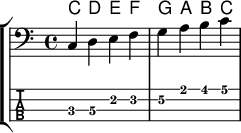
1b - F Major - F - G - A - Bb - C - D - E #
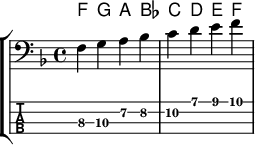
2b - Bb Major - Bb - C - D - Eb - F - G - A #

3b - Eb Major - Eb - F - G - Ab - Bb - C - D #

4b - Ab Major - Ab - Bb - C - Db - Eb - F - G #

5b - Gb Major - Gb - Ab - Bb - Cb - Db - Eb - F #

6b - Db Major - Db - Eb - F - Gb - Ab - Bb - C #

7b - Cb Major - Cb - Db - Eb - Fb - Gb - Ab - Bb #

Software #
Piano booster #
sudo pacman -S ttf-dejavu yay –noconfirm -S pianobooster
fluydsynth qjackctl
Links #
Music theory websites music-theory #
Music Theory Cheat Sheet: Keys, Scales, Chords, Notes & Intervals #
- Source: https://muted.io/cheat-sheet/
- Title: Music Theory Cheat Sheet: Keys, Scales, Chords, Notes & Intervals
- Captured on:
Musescore: online music courses | Learn how to play, read and compose music with the world’s largest sheet music catalog #
- Source: https://musescore.com/courses
- Title: Musescore: online music courses | Learn how to play, read and compose music with the world’s largest sheet music catalog
- Captured on:
(winter promotion on the yearly plan) MuseScore PRO+
- Source: https://musescore.com/pro/landing/winter?feature=banner
- Title: MuseScore PRO+
- Captured on:
(sound lib) Installing Muse Hub on Arch-based Linux Distributions | MuseScore
- Source: https://musescore.org/en/node/353503
- Title: Installing Muse Hub on Arch-based Linux Distributions | MuseScore
- Captured on:
Harmonagon™ #
- Source: http://harmonagon.com/
- Title: Harmonagon™
- Captured on:
https://www.youtube.com/playlist?list=PLFKcevgRavAcrEcYSYv7Y-BEY5pyOH_Rf
Songs With The Same Chords / Hooktheory trends tool for composing #
- Source: https://www.hooktheory.com/trends
- Title: Songs With The Same Chords
- Captured on:
This FREE Tool Lets You Write PERFECT Chord Progressions Every Time 🎶 - YouTube compositionmarkovprogression #
- Source: https://www.youtube.com/watch?v=dompNrAGIBk
- Title: This FREE Tool Lets You Write PERFECT Chord Progressions Every Time 🎶 - YouTube
- Captured on:
Chords & Scales Reference guitarpianochordsscales #
- Source:
- Title: Chords & Scales Reference
- Captured on:
#fretflip - Pentatonic and diatonic scales guitarchordsscales #
- Source: https://fretflip.com/022576373392
- Title: #fretflip - Learn and Teach Guitar Online
- Captured on:
Music theory training software #
Learning the Piano on your Linux computer with Playground Sessions! - YouTube #
- Source: https://www.youtube.com/watch?v=H6UUX6u_Yfs
- Title: Learning the Piano on your Linux computer with Playground Sessions! - YouTube
- Captured on:
GitHub - la-jarre-a-son/midi-jar: MIDI Jar is a tool box for musicians, learners, streamers, that want to route MIDI message between devices, and display a piano or chords while playing, and integrate it on a video or on a Twitch stream. #
- Source: https://github.com/la-jarre-a-son/midi-jar
- Title: GitHub - la-jarre-a-son/midi-jar: MIDI Jar is a tool box for musicians, learners, streamers, that want to route MIDI message between devices, and display a piano or chords while playing, and integrate it on a video or on a Twitch stream.
- Captured on:
Ear training #
Intervals: Ear Training (MP3s) - Piano-ology #
- Source: https://piano-ology.com/chords/intervals-ear-training-mp3s/
- Title: Intervals: Ear Training (MP3s) - Piano-ology
- Captured on:
Backtracks #
JJazzLab #
- Source: https://www.jjazzlab.org/en/
- Title: JJazzLab
Fed up with boring backing tracks? Try JJazzLab and make your own dynamic backing tracks in just a few minutes!
Music theory in the terminal or libraries #
[Lessons/Training Linux-Sound] / linuxaudio.org #
- Source: https://wiki.linuxaudio.org/apps/educational_apps
- Title: Lessons/Training [Linux-Sound]
- Captured on:
gciruelos/musthe: Music theory implemented in Python. Notes, intervals, scales and chords. #
- Source: https://github.com/gciruelos/musthe
- Title: gciruelos/musthe: Music theory implemented in Python. Notes, intervals, scales and chords.
- Captured on:
GitHub - synestematic/kord: a music theory development framework in python python #
- Source: https://github.com/synestematic/kord
- Title: GitHub - synestematic/kord: a music theory development framework in python
- Captured on:
https://github.com/yuma-m/pychord #
GitHub - pedrozath/coltrane: 🎹🎸A music theory library with a command-line interface ruby #
- Source: https://github.com/pedrozath/coltrane
- Title: GitHub - pedrozath/coltrane: 🎹🎸A music theory library with a command-line interface
- Captured on:
GitHub - Rainbow-Dreamer/musicpy: Musicpy is a music programming language in Python designed to write music in very handy syntax through music theory and algorithms. composition #
- Source: https://github.com/Rainbow-Dreamer/musicpy
- Title: GitHub - Rainbow-Dreamer/musicpy: Musicpy is a music programming language in Python designed to write music in very handy syntax through music theory and algorithms.
- Captured on:
kennethreitz/pytheory: Music Theory for Humans. #
- Source: https://github.com/kennethreitz/pytheory?tab=readme-ov-file
- Title: kennethreitz/pytheory: Music Theory for Humans.
- Captured on:
allan-simon/linthesia: tentative to fix/rewrite linthesia , an open-source synthesia/ “piano-hero” like game #
- Source: https://github.com/allan-simon/linthesia
- Title: allan-simon/linthesia: tentative to fix/rewrite linthesia , an open-source synthesia/ “piano-hero” like game
- Captured on:
ZaneH/piano-trainer: Memorize piano scales with ease! A piano practice program w/ MIDI support. Consider it an interactive reference manual 🎹 #
- Source: https://github.com/ZaneH/piano-trainer?tab=readme-ov-file
- Title: ZaneH/piano-trainer: Memorize piano scales with ease! A piano practice program w/ MIDI support. Consider it an interactive reference manual 🎹
- Captured on:
Music analysis #
Tabs that show the theory behind songs - Hooktheory #
- Source: https://www.hooktheory.com/theorytab
- Title: Tabs that show the theory behind songs - Hooktheory
- Captured on:
Example 1: #
https://vm.tiktok.com/ZMMFdBrmN/
D minor scale
2122122 - 2⁄5
1 D 2 E 3 F 4 G 5 A 6 Bb 7 C 8 D
i(Dm) - VI(Bb) - VII© - i(Dm) i(Dm) - III(F) - VII© - i(Dm)
Roundabout by Yes #
https://www.facebook.com/reel/911527620516572
E - F# - G A - B - A D - E - D
First note is E, so it must be E major or E minor.
Since there is one sharp, it is E minor.
Please explain the music theory behind Tool’s sound? : r/ToolBand #
- Source: https://www.reddit.com/r/ToolBand/comments/cwcru8/please_explain_the_music_theory_behind_tools_sound/
- Title: Please explain the music theory behind Tool’s sound? : r/ToolBand
- Captured on: A lot of their music involves polyrhythms, polymeters and odd time signatures as far as rhythm goes, in terms of harmony, their music is pretty straightforward and tonically centered.
Polyrhythms mean that there is several different rhythms or time signatures playing at once, at different tempos but lining up at every measure-For instance danny playing 7 notes in the time it takes adam to play 4.
Polymeters is when there is several rhythms or time signatures occurring but they are consistently going in and out of sync, for instance danny plays in 4⁄4 while adam plays in 7⁄8, meaning that Adam starts his part of the song in a different place every time and it takes 7 times for it to line up again.
Odd time signatures just mean that the music is measured and calculated in an unconventional way. 7⁄8, 5⁄4, 11⁄8, ect. top number specifies the amount of beats, and bottom number specifies the type of beat.
As far as Harmony & Melody Tool plays in D minor Phrygian and Dorian a lot which give tool their very dark, melancholy tonality. The music is also really centered around the tonic which gives it that really hypnotic and tribal type of sound.
BPM and key for songs by TOOL | Tempo for TOOL songs | SongBPM | songbpm.com #
- Source: https://songbpm.com/@tool
- Title: BPM and key for songs by TOOL | Tempo for TOOL songs | SongBPM | songbpm.com
- Captured on:
Music diagrams, cheat sheets, fretboard, piano #
Fretboard Diagram Creator #
- Source: https://verzettelung.com/20/12/22/
- Title: Fretboard Diagram Creator
- Captured on:
(example) Exploring Modes on the Guitar
- Source: https://verzettelung.com/20/12/22/modes.html
- Title: Exploring Modes on the Guitar
- Captured on:
Illustrated Jazz Theory #
- Source: https://verzettelung.com/24/01/07/
- Title: Illustrated Jazz Theory
- Captured on:
#fretflip - The only two scale shapes to learn? #
- Source: https://fretflip.com/02254235231
- Title: #fretflip - The only two scale shapes to learn?
- Captured on:
#fretflip - Note patterns to navigate the fretboard #
- Source: https://fretflip.com/02979588207
- Title: #fretflip - Note patterns to navigate the fretboard
- Captured on:
#fretflip - Play Ukulele and Bass on a Guitar #
- Source: https://fretflip.com/02651907625
- Title: #fretflip - Play Ukulele and Bass on a Guitar
- Captured on:
Hooktheory - CheatSheet chordspopularitykeyscheatsheet #
- Source: https://www.hooktheory.com/cheat-sheet
- Title: Hooktheory - CheatSheet
- Captured on:
Music theory visualization systems #
Keyboard #
VISUALIZE Chords, Forget Memorizing - YouTube
- Source: https://www.youtube.com/watch?v=RTDjplRWxI4
- Title: VISUALIZE Chords, Forget Memorizing - YouTube
- Captured on:
TonnetzViz | Online MIDI Visualization
- Source: https://cifkao.github.io/tonnetz-viz/
- Title: TonnetzViz | Online MIDI Visualization
- Captured on:
Guitar #
Chairworks 1-Major Chairs - YouTube
- Source: https://www.youtube.com/watch?v=sPT5mr4UFAk
- Title: Chairworks 1-Major Chairs - YouTube
- Captured on:
Chairworks 2-Minor Chairs - YouTube
- Source: https://www.youtube.com/watch?v=O4XlpBCi2J8
- Title: Chairworks 2-Minor Chairs - YouTube
- Captured on:
Chairworks 3-The Whole Fretboard (Pentetonic notes) - YouTube
- Source: https://www.youtube.com/watch?v=PwrWCsHbE40
- Title: Chairworks 3-The Whole Fretboard (Pentetonic notes) - YouTube
- Captured on:
Visual Triads (Extended) - YouTube
- Source: https://www.youtube.com/watch?v=TErJhRZX8kI
- Title: Visual Triads (Extended) - YouTube
- Captured on:
Music theory software to practice #
PianoBooster #
- Source: https://www.pianobooster.org/index.html
- Title: PianoBooster
- Captured on:
PolyMeilex/Neothesia: Flashy Synthesia Like Software For Linux,Windows and MacOs #
- Source: https://github.com/PolyMeilex/Neothesia
- Title: PolyMeilex/Neothesia: Flashy Synthesia Like Software For Linux,Windows and MacOs
- Captured on:
Music production software on linux #
- Reaper
- Ardour
- Musescore
- Q tractor
- LLMS
- Rosegarden
- Lilypond
- Frescobaldy
- Denemo
- Audacity
- Hydrogen (drum machine)
- Guitarix
- Tux Guitar
DAW Comparison for Linux (LMMS, Qtractor, Ardour) - YouTube #
- Source: https://www.youtube.com/watch?v=OkwOxWnwPeI
- Title: DAW Comparison for Linux (LMMS, Qtractor, Ardour) - YouTube
- Captured on:
5 free and open music-making tools | Opensource.com #
- Source: https://opensource.com/life/16/2/5-music-making-tools
- Title: 5 free and open music-making tools | Opensource.com
- Captured on:
“Aaron Wolf | Music Lessons in Portland & Oregon City: Guitar, Music Science, and more #
- Source: https://blog.wolftune.com/p/software-recommendations-and-more.html
- Title: “Aaron Wolf | Music Lessons in Portland & Oregon City: Guitar, Music Science, and more
- Captured on:
Music app websites #
BeatScratch: funk at your fingertips #
- Source: https://beatscratch.io/
- Title: BeatScratch: funk at your fingertips
- Captured on:
Plugins #
Linux Audio Plugin Options - YouTube #
- Source: https://www.youtube.com/watch?v=IaDoRa5n8nQ
- Title: Linux Audio Plugin Options - YouTube
- Captured on:
BBC SO #
Howto Reaper + BBC SO https://linuxmusicians.com/viewtopic.php?t=22480 https://www.reddit.com/r/linuxaudio/comments/vj9gmw/how_to_run_spitfire_labs_on_linux/
More plugins #
https://www.youtube.com/watch?v=OCzf38fCqB4
Devices #
Audio is Coming To Linux! - YouTube #
- Source: https://www.youtube.com/watch?v=YyUbnGWktek
- Title: Audio is Coming To Linux! - YouTube
- Captured on:
Scale degrees #
Names and symbols used in harmonic analysis to denote tones of the scale as roots of chords. The most important are degrees I = tonic (T), IV = subdominant (S) and V = dominant (D).
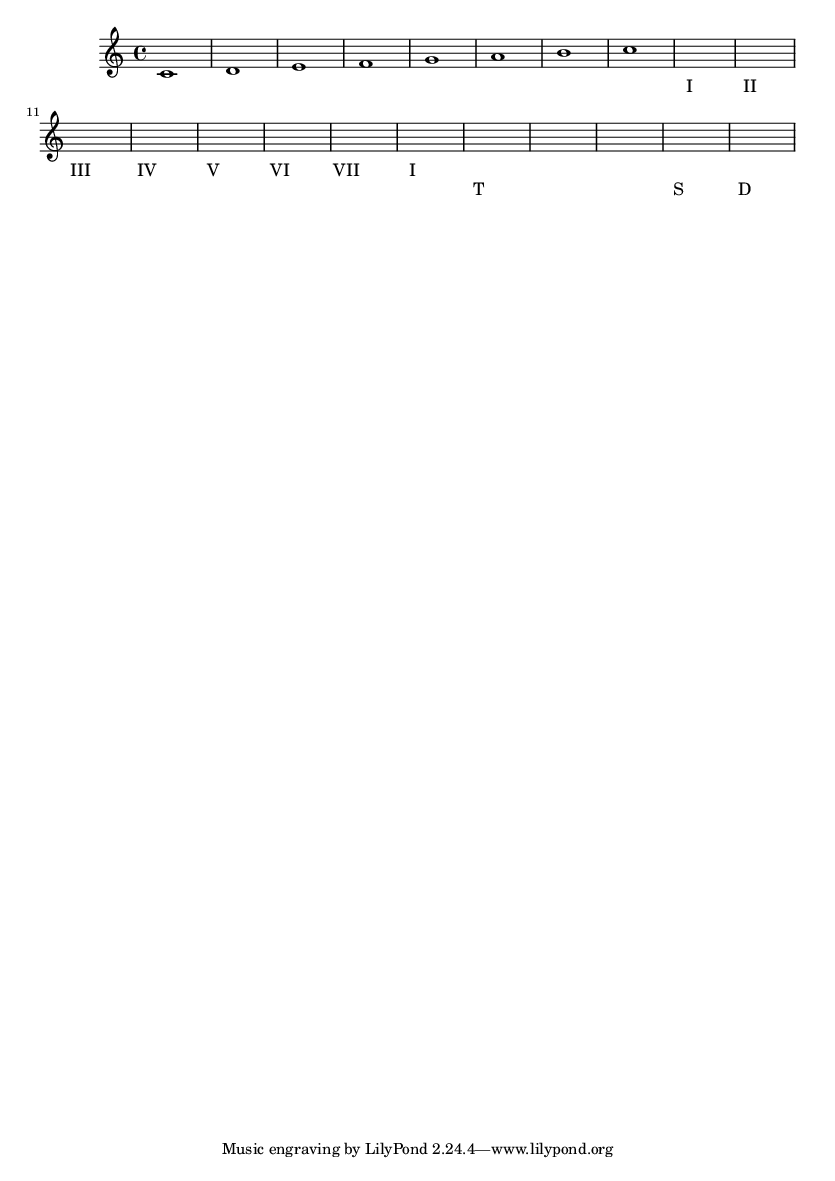
Diatonic scales #
A scale consisting of 5 whole tones and 2 semitones (S). Scales played on the white keys of a piano keyboard are diatonic.


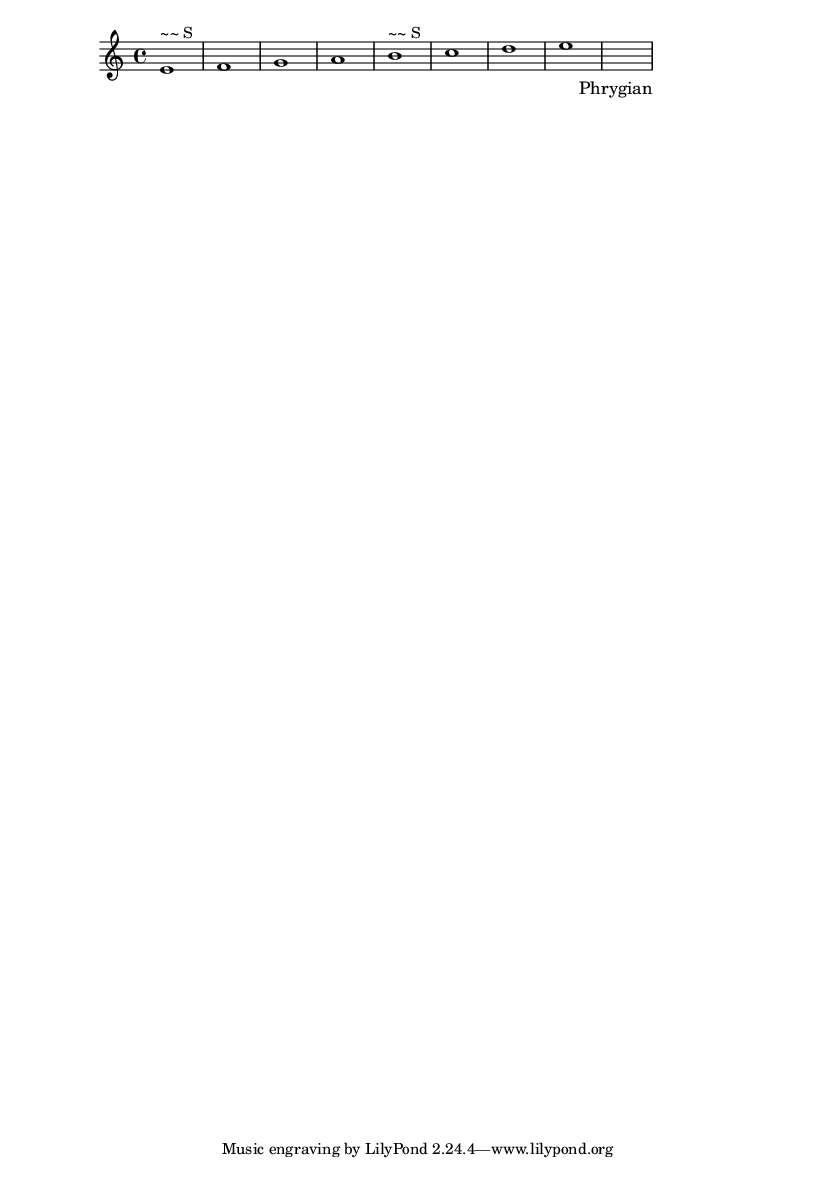
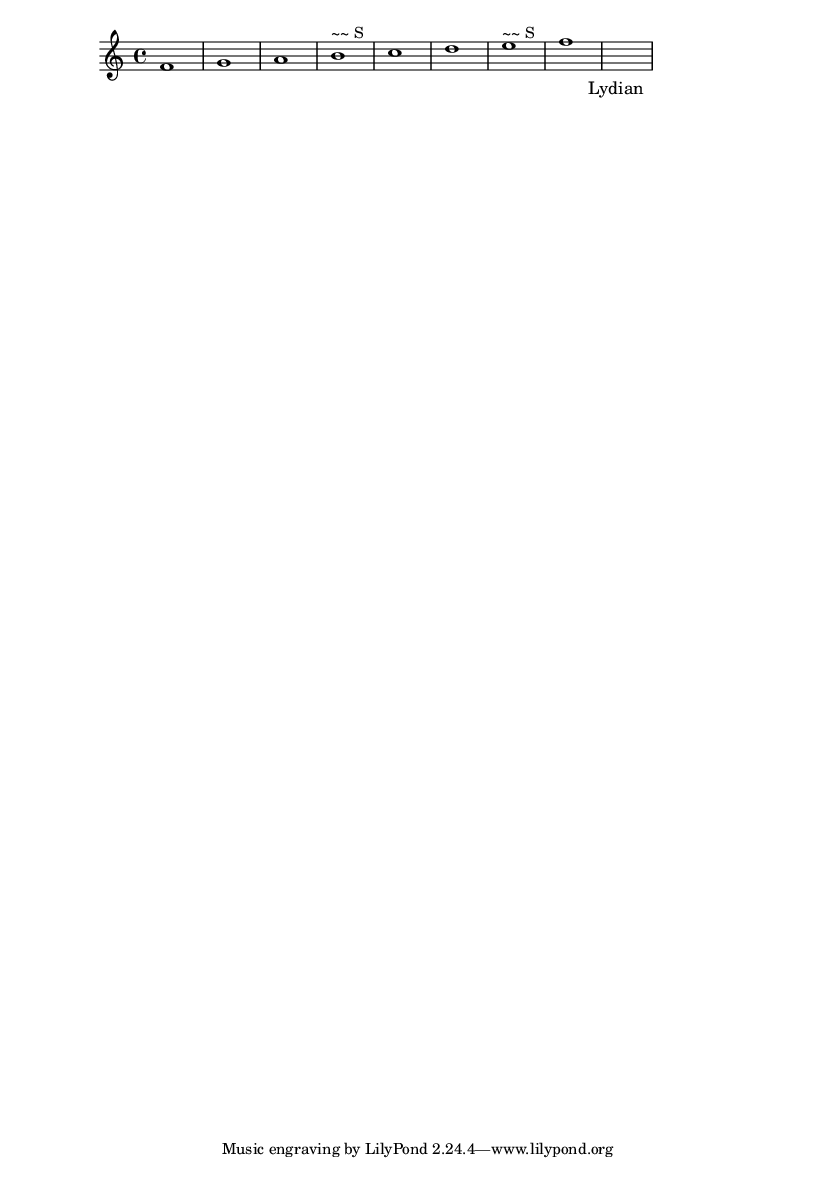
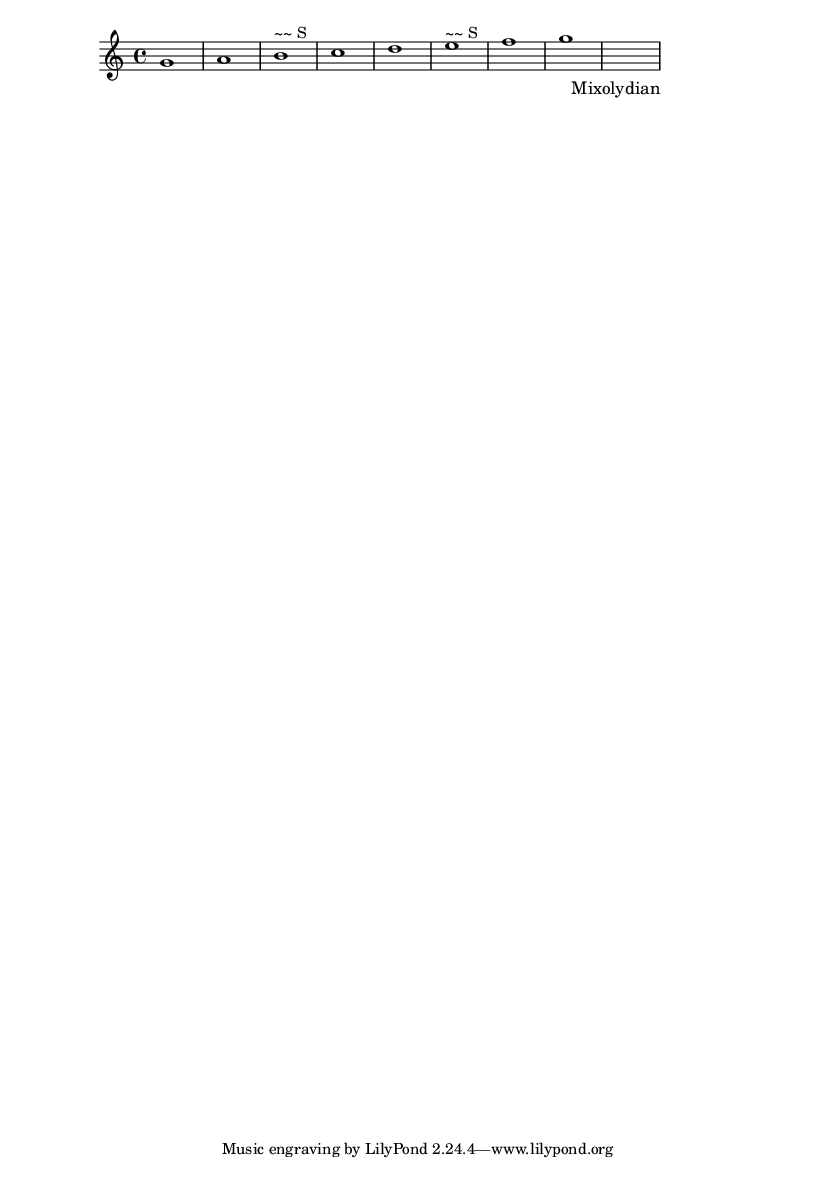
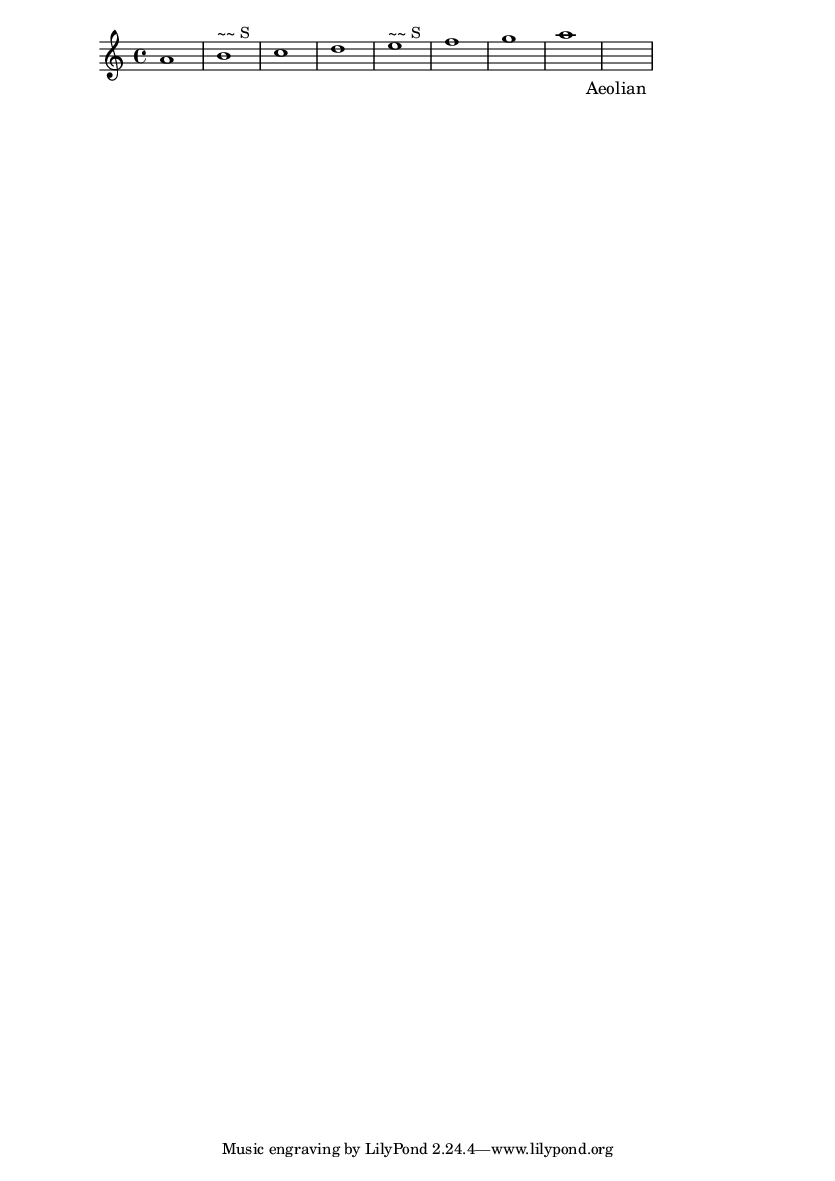
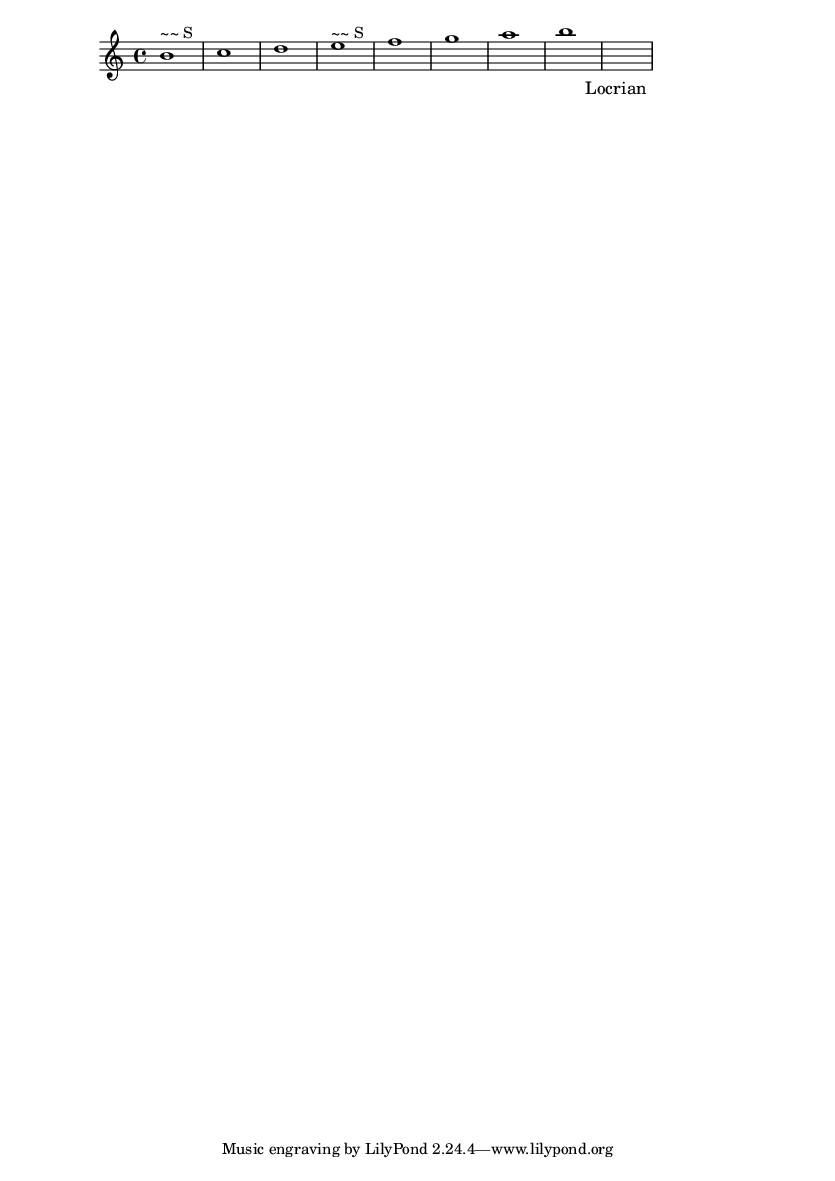
Awesome music #
GitHub - vpavlenko/study-music: An “awesome music theory” kinda wiki with books, resources and courses for studying everything about music and sound #
- Source: https://github.com/vpavlenko/study-music/tree/main
- Title: GitHub - vpavlenko/study-music: An “awesome music theory” kinda wiki with books, resources and courses for studying everything about music and sound
- Captured on:
GitHub - noteflakes/awesome-music: Awesome Music Projects #
- Source: https://github.com/noteflakes/awesome-music
- Title: GitHub - noteflakes/awesome-music: Awesome Music Projects
- Captured on:
Things to organize #

